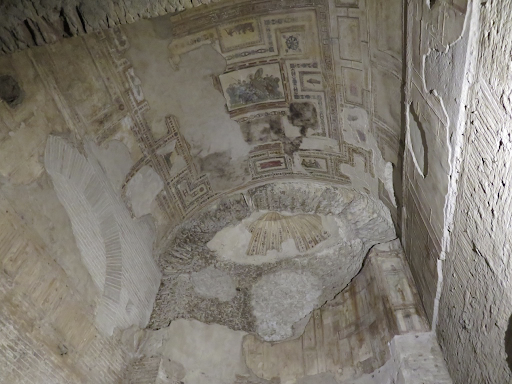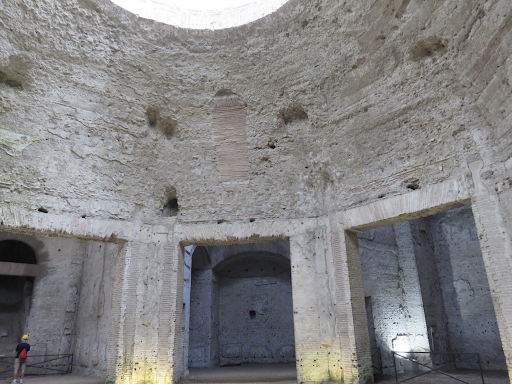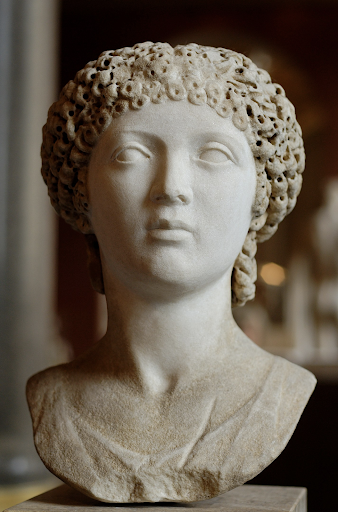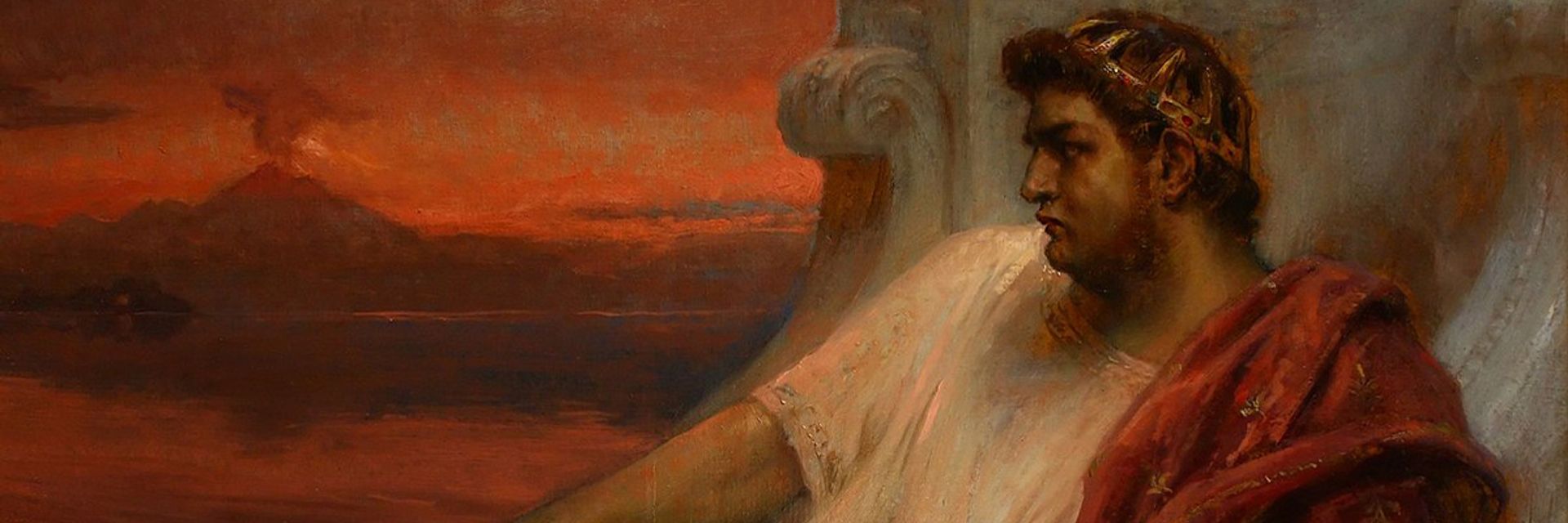Our view of Nero has unfortunately been shaped by Hollywood, which based its depictions on the accounts of Roman historians, primarily Suetonius and Tacitus. These two freely reported the rumors swirling around their subjects, i.e., the Roman ruling class. However, the truth is far more nuanced than movies and television shows would have us believe. In reality, the first part of Nero’s reign was marked by generosity and humbleness, disdain for military ventures, and pursuit of music and theater. He was a very different kind of emperor from his predecessors, and may not have fully deserved his reputation for depravity.
◊
Wearing yellow construction hard hats, our group entered the Domus Aurea, Nero’s legendary Golden House, walking tentatively in the darkened corridors. A somewhat off-the-beaten path Roman tourist site, the circa first century C.E. Golden House is within view of the more heavily visited Colosseum. The fact that it can be seen at all would surely displease Nero’s later successor Trajan, who ordered Domus Aurea buried under a mountain of landfill almost 2,000 years ago. Thanks to ongoing archeological efforts, the public now has some access to the site, as Trajan’s attempt to wipe out Nero’s memory is slowly being undone by the excavators.
Our view of Nero as mercilessly depraved and indifferent to the plight of ordinary Romans – ‘fiddling while Rome burned’ – has been virtually hard-wired into the popular imagination by somewhat unreliable historians of his time and modern depictions in literary works that were adapted to television and cinema (I, Claudius and Quo Vadis, respectively). But on my tour of the Domus Aurea, I first heard a different account of Nero from our guide. In fact, she suggested, he wasn’t just the poster boy of early Empire decadence, and didn’t deserve the simplistic image of an unhinged autocrat that we have absorbed.
The familiar story of Nero has come down to us primarily through the historian Suetonius, who had unique access to archival material, as well as through Tacitus, another historian of that period. To understand their accounts, we’ll need to appreciate the context in which the stories were written. Certain facts of life completely familiar to the Romans – debauchery of emperors, sordid political conspiracies, gruesome deaths of leaders – now require some historical explication on our parts.
Not surprisingly, Nero fits the overall pattern of his predecessors, emperors Augustus, Tiberius, Caligula, and Claudius, who wielded absolute control over citizens and slaves, and were unrestrained in their craving for power, riches, fame, and sex. As Romans, these traits were not necessarily considered character flaws. Tacitus unsparingly notes, “All things atrocious and shameless flock from all parts to Rome.”
With an eye toward the Roman values and norms of the time, historians have begun to reconsider Nero’s reign. Instead of finding a maniacal dictator, they are seeing an enlightened scholar-athlete-musician whose artistic sensibilities could have become the model for a different kind of Roman ruler.
Watch Nero's Golden House on MagellanTV.
Fires and the Facts of Plebeian Life in Rome
We have Suetonius to thank for the meme that Nero started the fire that devastated Rome in 64 C.E. According to him, Nero’s goal might have been to clear out warehouses that were in the way of his massive Domus Aurea project:
“… pretending to be disgusted with the old buildings, and the narrow and winding streets, he set the city on fire so openly, that many of consular rank caught his own household servants on their property with tow, and torches in their hands, but durst not meddle with them. There being near his Golden House some granaries, the site of which he exceedingly coveted …” —Suetonius, The Lives of the Twelve Caesars
His contemporaries were well aware that fires were an unfortunate fact of life as Rome grew to a sprawling city of one million in the first century C.E. By this time, Rome’s inhabitants were mostly former citizen-farmers who left the poverty of the countryside for a better life in the city. They had been pauperized by the rise of the slave-based latifundia, huge plantations concentrated in the hands of the wealthy. In the cities, this newly displaced class was packed into the first tenement apartments, known as insulae – literally meaning islands.
Numbering in the thousands by Nero’s time, the insulae were poorly constructed, built of combustible wood, mud, and brick, and with very limited allowances for running water, sewage, and cooking. To make a hot meal meant starting a fire on the floor of the apartment, potentially resulting in the obvious consequences.
Writing about Augustus, the first of the Twelve Caesars and Nero’s great grandfather, Suetonius commented that Rome “was not built in a manner suitable to the grandeur of the empire, and was liable to inundations of the Tiber, as well as to fires.” To his credit, Augustus implemented a permanent fire-fighting force, dividing the city into 14 districts and assigning a brigade of night watchmen – vigiles urbani – to be on the lookout for flames. However, they were equipped with little more than buckets of water and could control only the smallest of incidents.
Nero’s Life of Luxury on the Palatine Hill
The wealthy patrician class, like Nero, lived in far safer surroundings – their villas sat high on the Palatine Hill, far above the poorer neighborhoods of the Roman proletariat. Built from marble and concrete, these houses had the latest Roman technology: plumbing, heated floors, and kitchens. As I walked through the Domus Aurea and gazed upon the fading frescos on the concrete walls and high arched ceilings, this structure did not look its 2000-year old age. Instead I felt like we were standing in a 1960s-era hotel that had seen a better day.

Fading remains of beautiful frescoes painted on the ceilings of the Domus Aurea (Photo by Andy Green)
At the end of my visit, we arrived at the innovative octagonal room, which was lit from above by an opening (or oculus) that let in the glowing sunlight. In its day, it was used as a summer room and had views of the park-like grounds. The patrician Romans, and Nero especially, lived well. Nero’s mistake may have been in building his opulent palace in Rome, for all to see, rather than like other patricians, saving their most extravagant dwellings for the countryside.
A Fire Sparks the Myth of Nero’s Evil Indifference
The fire of 64 C.E. was the city’s worst, and started far from the Domus Aurea at the Circus Maximus, where Romans went to sit in wooden stands and bet on the chariot races. It quickly spread to all 14 districts, and the city, at least the poorer neighborhoods, lay in ruins. But what could one do with pre-industrial technology to fight an inferno fed by housing still mostly built from wood?
Nero’s singing might not have been such a depraved response to the Romans’ helplessness against far more powerful natural forces.

The eerily modern octagonal room in the Domus Aurea, lit from above by its distinctive oculus (Photo by Andy Green)
Suetonius says of Nero that he was “so extremely fond of singing and dancing, that he could not refrain from singing with the tragedians, and imitating the gestures of the actors.” He enjoyed performing at the Roman games as a kind of half-time show between chariot races, processions of exotic animals, and gladiatorial fights.
For Nero the tragic fire was worthy of a song, and, in this case, he likened Rome to fabled Troy and sang about its destruction by the Greeks. (Think about how musicians responded to the tragic events of 9/11.) Less well known is that Nero then opened up his own home to the newly homeless, constructed other temporary dwellings, and brought in food from the great Roman port at Ostia. These are not the actions of a heartless monster.
Earlier in his reign Nero even took an interest in the architecture of the city, specifically ordering piazzas to be built in front of houses as a kind of fire barrier. That’s right: Nero actually did something about the constant threat of fire! As I learned more about him, I began to see why scholars are now reconsidering the reign of this rebel Roman. They are de-emphasizing some of the more lurid aspects of Nero’s rule and re-interpreting his supposed debauchery as rumors and innuendos spread by his enemies.
Portrait of the Artist as Emperor
Nero’s path to supreme ruler began with his mother Agrippina’s marriage to the Emperor Claudius. Her previous husband died under mysterious circumstances, and was possibly poisoned. Under her prodding, Claudius then adopted the 13-year-old Nero Claudius Caesar Augustus Germanicus. Four years later in 54 C.E., Claudius died suddenly, likely due to eating poisoned mushrooms prepared by chef Agrippina, and the bookish teenager Nero became Rome’s youngest ruler.
Suetonius says Nero wanted to restore Augustus’s governance model of “generosity, clemency, and complaisance” that had been interrupted by the likes of Caligula. He quickly eliminated or greatly reduced taxes, and he displayed a streak of very un-Roman egalitarianism by pointedly saluting people by name, as Seutonious notes. Like Augustus, he also showed deference to the Roman Senate, which under the Empire had lost its powers and was now merely a symbol of the former Republic.
Rather than expanding the empire, Nero built upon Augustus’s Pax Romana model and even considered withdrawing legions from Britain. His earliest teacher and adviser was Seneca, the stoic philosopher, who gave him a grounding in the liberal arts, leading him to focus not on military conquests but rather on the arts – music, poetry, and theater.
After the young Nero donned the purple toga of power, Seneca along with Agrippina were effectively running the show. Interestingly, Seneca was eventually accused of amassing riches under Nero’s rule – this stoic did indeed become wealthy – and fell out of favor, ultimately forced to commit suicide. He was one of many to meet a horrid fate during the latter part of Nero’s reign.
The young emperor was convinced of his artistic greatness and ordered his own games, the Neronia, in which he was, not surprisingly, the center of attention. He put on the actor’s mask, and Suetonius says his repertoire included “Orestes the Murder of his Mother,” and “Oedipus Blinded” – telling choices considering what was to transpire later.
Nero also learned charioteering, another highly unusual hobby for a Caesar, and participated in racing contests. In all his artistic and athletic pursuits, he is portrayed as not wanting special favors from the judges, even as he, ahem, happened to win awards and praise.
What did Roman high society think of his activities?
Tacitus strongly suggests they felt he was leading Rome and its youth to laziness and licentiousness. After all, his encouragement of theatre and singing were considered somewhat feminine pursuits, and Rome required soldiering and military arts – and not listening to “emasculated music and dulcet voices.”
The Final Years: Murder, Sex, Debauchery
While the early years of his reign were somewhat enlightened and progressive by Roman standards, by the time of the great fire his egotism and paranoia had gotten the better of him.
First, there was the matter of his mother Agrippina. He rebelled against an arranged marriage to Claudia Octavia, Claudius’s daughter and Nero’s stepsister, by starting an affair first with the freedwoman Acte, and then with someone of his own class, the beguiling Poppaea Sabina. Agrippina disapproved of both. In fact, the Romans believed that to maintain her hold on power, Agrippina was trying to seduce Nero herself to keep him from straying. Or perhaps it was Nero who was interested in exploring an incestuous relationship with Agrippina. The Romans and their rumors!
Under advice from Seneca, Nero exiled Agrippina from Rome to Rhodes as a way to consolidate his own hold on power. Apparently distance did not make his heart grow fonder, and he then plotted matricide. The ancient sources speak of various attempts to murder Agrippina through poisoning – which failed – and then by drowning on a boat that Nero himself had arranged to leak and sink. Agrippina survived the capsizing and swam to shore. Nero finally brought trumped up assassination charges against the formerly unsinkable Agrippina and had her executed. Even the jaded Romans were shocked.

Bust of Poppaea (Source: Palazzo Massimo)
Besotted with Poppaea, but still married to Octavia, Nero decided on his next course of action. He divorced and banished Octavia, and married Poppaea. Neither his new nor former wife fared well. A story goes that Nero then murdered Octavia and brought her head back to show Poppaea. And in a fit of rage in 62 C.E., Suetonious reports he kicked the pregnant Poppaea, killing her. Well, maybe. Nero’s enemies were only too willing to believe the worst.
Increasingly isolated, he craved sex and other titillations – “abuse of free-born lads, and the debauch of married women.” It is said that on his jaunts down to Baie, a wealthy Roman seaside resort town, his acolytes had set up brothels along the shore of the Tiber for his entertainment.
A Typically Roman End to Nero’s Reign
The whole thing ended as gruesomely as it started. In 65 C.E., Nero uncovered a plot against him. It was led by the Gaius Calpurnius Piso, a famed orator, and involved members of the all-important equestrian class (a kind of upper middle class). The revolt was quickly extinguished, with many of the conspirators executed or forced to commit suicide.
Disgusted by Nero’s reign and overall spending profligacy, Roman legions in the provinces led by Servius Sulpicius Galba, the governor of Spain, finally overthrew the singing emperor. He was declared an enemy of the state by the Senate, and rather than facing a slave’s death – crucifixion – Nero killed himself.
Was Nero really worse than the other emperors and generals of that era? Emperor Tiberius Caesar had his Isle of Capri for his own peculiar pleasures, Pompey the Great was known as the teenage butcher, and Augustus’s rise to becoming First Citizen rested on a giant bone heap of his victims. It appears that Nero’s love of acting and, more disgracefully, playing the parts of beggars and non-nobles, was too much for the Romans to bear.
Nero may have had the final say. At the end of my visit to Nero’s home, I learned that early Renaissance artists Michelangelo and Raphael knew of the buried Domus Aurea, and had explored some of its rooms. They studied the beautiful frescos and classic Greek sculptures that Nero had collected, which greatly influenced their own art and which then shaped Western art. Ars longa, vita brevis. Life is short, but art endures.
Ω
Title Image: "Nero at Baiae," Jan Styka (Credit: Wikimedia Commons via M0tty)
Nero and Caligula are popularly believed to have been the most depraved of the early Roman emperors. But who was worse? Now that you’ve learned about Nero, click here to read MagellanTV contributor Justine Damiano’s take on “Sex and Violence in Rome: Caligula’s Empire and the Salacious Rumors that Built It.”

